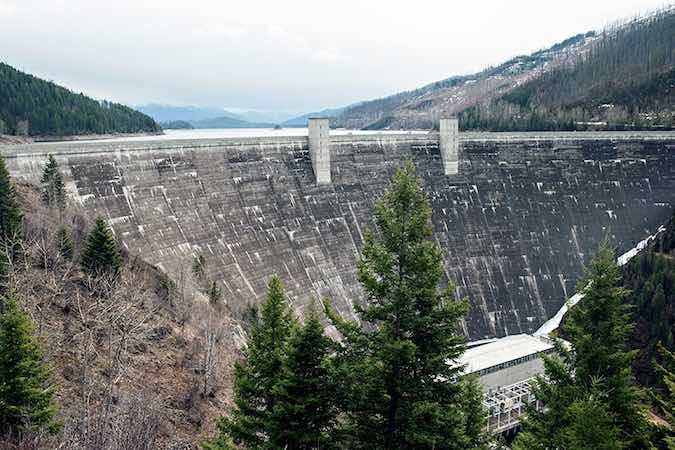forum
library
tutorial
contact

Federal Agencies Examining
Columbia River Dam Operations
by Justin Franz
Flathead Beacon, October 31, 2016
|
the film forum library tutorial contact |

|
Federal Agencies Examining
by Justin Franz
|
Public meetings held in western Montana in wake of judge's ruling
that dams have negative impacts on salmon and steelhead
 The federal agencies responsible for the operation of more than a dozen dams in the Pacific Northwest -- including two in Northwest Montana -- are analyzing how to adjust operations within the Columbia River Basin to comply with the Endangered Species Act.
The federal agencies responsible for the operation of more than a dozen dams in the Pacific Northwest -- including two in Northwest Montana -- are analyzing how to adjust operations within the Columbia River Basin to comply with the Endangered Species Act.
The U.S. Army Corps of Engineers, Bureau of Reclamation and Bonneville Power Administration are working on a revised environmental impact statement after a federal judge ruled that the operation of 14 dams, including the Hungry Horse and Libby dams, is having a negative impact on salmon and steelhead. The three agencies have been hosting meetings across the Pacific Northwest, including one in Kalispell on Nov. 1, Libby on Nov. 2, and Missoula on Nov. 3.
"We want people be able to provide input on how to operate the system because there are so many competing interests," said U.S. Army Corps of Engineers spokesperson Amy Gaskill.
The dams of the Columbia River Basin have been described as a "complex system" built to create hydro-electricity and offer flood control for the Pacific Northwest. The dams in the United States and others in Canada were the result of the Columbia River Treaty, a groundbreaking international agreement between the two nations signed in 1964.
The Columbia River Basin dams have been the subject of numerous lawsuits in recent decades because of their impacts on salmon and steelhead, both of which were given protected status in the 1990s. The National Marine Fisheries Service, the federal agency responsible for the stewardship of marine resources, has maintained that the dams do not negatively impact the fish. But earlier this year, U.S. District Court Judge Michael Simon in Oregon ordered the agencies to take another look at the dams' impact on their environment. In a 149-page ruling, he noted that none of the federal agencies have considered how climate change would impact the river system or fish.
"The Court finds that NOAA Fisheries' assertion that the effects of climate change have been adequately assessed in (a 2014 biological opinion) is not 'complete, reasoned, or adequately explained,'" Simon wrote. "NOAA Fisheries' analysis does not apply the best available science, overlooks important aspects of the problem and fails (to properly) analyze the effects of climate change."
The federal agencies will be gathering public input on river and dam operations from now until Jan. 2017, and hope to issue a new draft environmental impact statement in Fall 2019 or Spring 2020. For more information, visit www.crso.info.
Sockeye recovery plan completed in 2015Last year, NOAA Fisheries completed a recovery plan for sockeye salmon, which used to return in great numbers to Redfish Lake and other lakes north of Ketchum. NOAA's Interior Columbia Technical Recovery Team proposed biological viability criteria that must be met before Snake River sockeye salmon can be delisted from "endangered" status. NOAA reports that a minimum of 1,000 wild spawners must be achieved in both Redfish Lake and Alturas Lake. The minimum spawning abundance threshold for Pettit, Stanley or Yellowbelly lakes is 500 wild spawners. This year, a total of 574 sockeye salmon returned from the ocean to the Sawtooth Valley. Of those, 329 continued into Redfish Lake to spawn, while Idaho Fish and Game brought the other 245 into their hatchery program to spawn in captivity and produce more captive-raised fish. In addition to those fish returning from the ocean, Idaho Fish and Game released 786 captive-reared fish into Redfish Lake to spawn, and another 100 fish into Pettit Lake to spawn there. "The benchmark of 1,000 returning fish cited in the recovery plan refers to fish returning from the ocean, so the captive-reared fish do not count toward that total," said NOAA Fisheries spokesman Michael Millstein.
Idaho Mountain Express, by Tony Evans November 2, 2016
learn more on topics covered in the film
see the video
read the script
learn the songs
discussion forum
